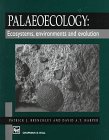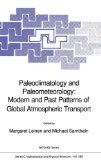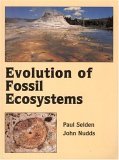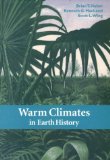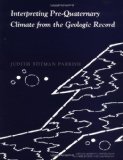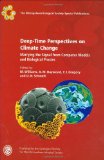|
Palaeoecology
Discusses such subjects as: factors controlling the distribution of species; taxonomic uniformitarianism; shell morphology; trace fossils; taphonomy; principles of community palaeoecology; and pre-cambrian and cambrian benthic communities. |
|
Paleoclimatology and Paleometeorology: Modern and Past Patterns of Global Atmospheric Transport
This volume should be a valuable reference for those, such as geomorphologists, climatologists and quaternary geologists, who specialize in its subject matter |
|
Evolution of Fossil Ecosystems
Beginning with a general introduction to fossil Lagerstätten, Evolution of Fossil Ecosystems goes on, chapter by chapter, to consider each fossil site, detailing its evolutionary position and significance; a brief history of the locality; its background sedimentology, stratigraphy, and paleoenvironment; its biota and paleoecology; and its commonalities with similar Lagerstätten. Considering deposits both marine and terrestrial, the book covers one fossil site from the Precambrian era, five sites from the Paleozoic era, five sites from the Mesozoic era, and three sites from the Cenozoic era.
Illustrated with hundreds of color photographs and drawings, Evolution of Fossil Ecosystems is a sophisticated yet accessible guide to these critical sites. Containing useful appendixes listing important museums, instructions on how to visit the fossil sites, and additional suggested reading, this book will attract students, academics, and professionals in paleontology, evolution, and the earth and life sciences, as well as dedicated amateurs interested in fossils and geology. |
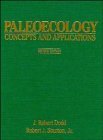
|
Paleoecology: Concepts and Applications, 2nd Edition
Revised and updated, it reflects the recent developments and changing emphasis in the field of paleoecology. While the basic organization remains the same as the original edition, there are several major changes, including an extensive reorganization and shortening of Chapter 2, focusing now on environmental parameters rather than individual taxonomic groups; greater use of tables with references to pertinent literature; inclusion of a new chapter on taphonomy; elimination of the chapter on skeletons as sedimentary particles; removal of many of the recurring examples from the Neogene of the Kettlemen Hills; and inclusion of new references on all topics. Older references have been kept and will serve to blend the historical and important milestones in the development of paleoecology with the most current research. |

|
Terrestrial Paleoecology & Global Change
This book critically evaluates the currently popular ideas of global change based on the plate tectonics, extraterrestrial impacts, greenhouse warming, etc. and offers alternative models. Krassilov presents ecosystem evolution as a sustainable oriented process with an increase in the biomass-to-dead mass ratio as a measure of progress. This general tendency is reversed the geobiospheric crises starting in the earth's interior and surfacing as the concerted geomagnetic, tectonomagmatic, geochemical and climatic events. These affect biota through turnovers of biotic communities and the adequate changes in population adaptive strategies, a major force under the species originations and extinctions, as well as the genomic evolution. The evolution of humans is envisaged as guiding this species to the role of the earth custodian.
The book is important for evolutionists, ecologists, geologists, climatologists, geneticists, integrative biologists, botanists, zoologists, and the general educated person who is intrigued by the dynamic historical processes which shape biodiversity evolution. It could be used as a course book for undergraduate and graduate studies and is an excellent example of inspiring and creative interdisciplinary research of our planet. Valentin Krassilov is the author of 20 books, among them the Palaeoecology of Terrestrial Plants, Cretaceous Period, Angiosperm Origins, Ecosystem and Egosystem Evolution, etc. The new book is based on his many year experience in the fields of palaeobotany, palaeoecology, structural geology and evolutionary biology. |

|
Terrestrial Ecosystems Through Time: Evolutionary Paleoecology of Terrestrial Plants and Animals
A joint undertaking of the Evolution of Terrestrial Ecosystems Consortium at the National Museum of Natural History, Smithsonian Institution, and twenty-six additional researchers, this book begins with four chapters that lay out the theoretical background and methodology of the science of evolutionary paleoecology. Included are a comprehensive review of the taphonomy and paleoenvironmental settings of fossil deposits as well as guidelines for developing ecological characterizations of extinct organisms and the communities in which they lived. The remaining three chapters treat the history of terrestrial ecosystems through geological time, emphasizing how ecological interactions have changed, the rate and tempo of ecosystem change, the role of exogenous "forcing factors" in generating ecological change, and the effect of ecological factors on the evolution of biological diversity. |

|
Evolutionary Paleoecology
This book will be an excellent supplement to advanced paleontology and enlightened evolution courses |
|
Warm Climates in Earth History
The study of greenhouse climates in the earth's past leads to a greater understanding of the factors that influence today's climate. In this fully integrated volume, leading experts in paleoclimatology present cutting edge paleontological, geological, and theoretical research to assess intervals of global warmth. Coverage examines warm climate intervals during the Paleozoic, Mesozoic and Cenozoic from the same perspectives: oceanic and terrestrial, theoretical and observational. This approach illuminates the differences and, more importantly, the commonalities of warm climate intervals. The book also provides a comprehensive overview of the advantages and limitations of different types of climate models that are currently used, and it discusses major factors that have caused global climatic change across geologic time scales. Central problems that remain unresolved are clearly identified. The book will be of great interest to researchers in paleoclimatology, and it will also be useful as a supplementary text in advanced undergraduate or graduate level courses in paleoclimatology and earth science. |

|
Climate Modes of the Phanerozoic
This book views the Earth's climate as a global system, by describing the evolution of climate throughout the past 600 million years, from the Cambrian to the Quaternary. Palaeoclimates are examined in terms of Cold and Warm modes--phases during which the Earth's climates were either relatively cool with ice forming in high latitudes or when high levels of CO2 led to "greenhouse" warmings and temperate floras and faunas inhabited polar regions. Evidence for climate changes, such as biological indicators, geochemical parameters, and the presence of ice, are compared between these modes. These studies have highlighted the crucial role of tectonics and continental distribution in governing ocean circulation, the distribution of sea ice, sea level changes and global temperature distribution. Orbital forcing and the carbon cycle are also shown as important influences, particularly on short term climatic variations. |
|
Interpreting Pre-Quaternary Climate from the Geologic Record
Within the geological science of paleoclimatology, the earth's pre-Quaternary period--more than two million years ago--has been studied systematically only since the 1960's, when geologists started to take seriously the concept that the continents have changed position on the earth's surface. In the decades since, the study of pre-Quaternary paleoclimatology has expanded greatly. A wide variety of methods have been developed to study pre-Quaternary climates, but until now, no single text has sought to synthesize those methods. Judith Totman Parrish's text offers a much-needed entry point into the literature. While a number of previous books have dealt with climate models and paleoclimate, this is the first to offer a sustained exploration of the methods that are the foundation of any interpretation of earth processes. Focusing primarily on the description and analysis of paleoclimatic indicators-signals of a particular climate--this valuable reference work offers detailed explanations of biotic and lithologic indicators in the marine and terrestrial realms and includes case histories of paleoclimatic studies. The most up-to-date and comprehensive volume on the subject, Interpreting Pre-Quaternary Climatefrom the Geologic Record will be an important resource for students and scientists alike. Parrish's focus on the established, underexploited, and controversial methods bring to light a spectrum of potential new avenues of research in this field. |
|
Deep-Time Perspectives on Climate Change: Marrying the Signal from Computer Models & Biological Proxies
This book unites climate modelling, palaeoceanography and palaeontology to address fundamental events in the climate history of Earth over the past 600 million years. Understanding the 'tipping points that have lead to rapid changes in the Earths climate is vitally important with the realization that humans modify global climate. In an effort to better understand past and future climate change, general circulation models have become the forerunners of attempts to simulate future climate. Although extraordinarily sophisticated, they remain imperfect tools that require grounding in geological data. In this, the study of past major climate transitions like the Palaeozoic icehouse worlds and the extreme greenhouse of the Cretaceous are invaluable. Both the mechanisms that forced changes in the Earth's climate as well as the proxies that track these changes are discussed. The central message of the book is that general circulation models tested with geological data in an iterative 'ground truth' process provide the best estimates of the Earth's ancient climate. |








